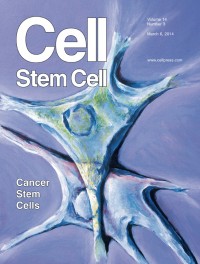Cell Stem Cell Q1 Unclaimed
Cell Stem Cell, launched in 2007 by Cell Press, publishes research articles and review materials with a focus on stem cells. Working closely with authors, reviewers, and the scientific editorial board, the editorial staff maintains the high standards of a Cell Press journal in its mission to publish timely results of broad interest to the field. In keeping with Cell Press policies, editorial decisions at Cell Stem Cell are made independently by its in-house editorial staff, and Cell Stem Cell co It has an SJR impact factor of 9,313.
Cell Stem Cell focuses its scope in these topics and keywords: stem, cell, cells, human, reprogramming, epigenetic, hematopoietic, induced, niche, pluripotent, ...
Type: Journal
Type of Copyright: CC BY
Languages:
Open Access Policy: Open Choice
Type of publications:
Publication frecuency: -


4733 €
Inmediate OANPD
Embargoed OA0 €
Non OAMetrics
9,313
SJR Impact factor316
H Index158
Total Docs (Last Year)507
Total Docs (3 years)10474
Total Refs6778
Total Cites (3 years)403
Citable Docs (3 years)12.67
Cites/Doc (2 years)66.29
Ref/DocOther journals with similar parameters
Molecular Cell Q1
Cell Research Q1
Annual Review of Plant Biology Q1
Nature Cell Biology Q1
Nature Metabolism Q1
Compare this journals
Aims and Scope
Best articles by citations
Molecular Targeting of Cancer Stem Cells
View moreTranscriptional Mechanisms of Proneural Factors and REST in Regulating Neuronal Reprogramming of Astrocytes
View moreThe RNA Helicase DDX6 Controls Cellular Plasticity by Modulating P-Body Homeostasis
View moreOvercoming Obstacles in the Search for the Site of Hematopoietic Stem Cell Emergence
View moreA Web of Imprinting in Stem Cells
View moreThere and Back Again: Hair Follicle Stem Cell Dynamics
View moreKiller Granzyme B Linked to N-myc- and c-myc-Dependent HSC Survival: Isn't That Comyc?
View moreGene-ectomy: Gene Ablation with CRISPR/Cas9 in Human Hematopoietic Cells
View moreStem-Cell-Derived Cardiomyocytes Grow Up: Start Young and Train Harder
View moreKonrad Hochedlinger: ISSCR Outstanding Young Investigator for 2009
View moreYour Heart on a Chip: iPSC-Based Modeling of Barth-Syndrome-Associated Cardiomyopathy
View moreHuman Somatic Cell Reprogramming: Does the Egg Know Best?
View moreDirect In Vivo Reprogramming with Sendai Virus Vectors Improves Cardiac Function after Myocardial Infarction
View moreIn Epigenetic Therapy, Less Is More
View moreWhat Endothelial Cells from Patient iPSCs Can Tell Us about Aortic Valve Disease
View moreAn Old Player on a New Playground: Bmi-1 as a Regulator of Prostate Stem Cells
View moreApoptotic Caspases Regulate Induction of iPSCs from Human Fibroblasts
View moreCommitting to a Hairy Fate: Epigenetic Regulation of Hair Follicle Stem Cells
View moreAn EZ Mark to Miss
View moreAnother Horse in the Meta-Stable State of Pluripotency
View moreIsolation and Production of Cells Suitable for Human Therapy: Challenges Ahead
View moreForces of Change: Mechanics Underlying Formation of Functional 3D Organ Buds
View moreThe Par Complex and Integrins Direct Asymmetric Cell Division in Adult Intestinal Stem Cells
View moreDirect Lineage Conversion of Terminally Differentiated Hepatocytes to Functional Neurons
View more
Comments